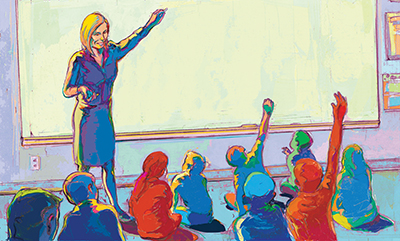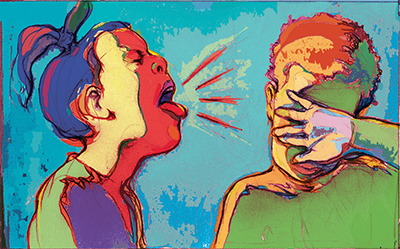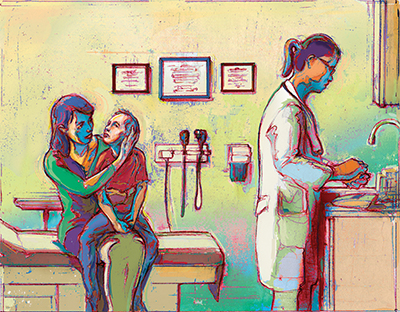
WHEN SAN ANSELMO mom Bibit Traut came down with pertussis (whooping cough) in April 2013, she coughed so hard she broke a rib. Her son Tavish, then a senior at Drake High School, hacked so much it made him vomit. Her other son, Riley, was coughing too, and for 12 weeks, everyone in the family except Bibit’s husband struggled to breathe and sleep.
Riley, then a sophomore, had contracted the disease from an outbreak at Marin Catholic. One kid passed it to another. And then each kid took it home. In Marin, this is a common story. Most parents of schoolage kids here have received multiple emails from a school nurse warning that their child has been exposed to pertussis or measles or some other vaccine-preventable disease. In the case of the Trauts, vaccines received years earlier had lost their effectiveness.
As the new school year begins, the reminders are likely to recur. Marin is once again in the midst of a pertussis epidemic. As of July, we’d had 170 cases — compared to a total of 188 in all of 2013.
When outbreaks happen in the county, they’re addressed not just with antibiotics but with a vigorous debate over vaccinations. That’s because Marin has the highest vaccine-refusal rate in the Bay Area and one of the highest in California. California is one of 17 states that allows for a “personal belief exemption” (PBE), giving parents the right to say no to immunizations for their child. In the 2013–2014 school year, 7.6 percent of all Marin kindergartners were not fully vaccinated because their parents opted out.
population to be immune to prevent infection
from spreading throughout the community.”
Why are Marin parents so reluctant to vaccinate? Many Marinites take a holistic approach to health, and some with those leanings believe vaccines tamper with the body’s natural systems or might even cause serious harm. Parents hear stories of kids who’ve gotten sick after a shot; some visit popular natural-health websites like that of Dr. Joseph Mercola, where articles link childhood vaccinations to everything from allergies, asthma and hay fever to autoimmune disorders, attention deficit hyperactivity disorder and autism. Over the past decade, Mercola has received several warnings from the Food and Drug Administration to stop making what it calls unfounded claims (unrelated to vaccines). Even though concerns about childhood vaccines have been refuted repeatedly in peer-reviewed medical journals, a seed of doubt has been planted in the minds of parents, who understandably can’t abide the idea of doing anything that might possibly cause their infants harm.

Statistically, vaccine hesitancy tends to cluster in affluent, health-oriented communities like Marin; Malibu; Portland, Oregon; andBoulder, Colorado. “One of my colleagues at the state level says that he can tell where the low vaccination rates are going to be,” says Willis. “He says, ‘Just draw a circle around where the Whole Foods are located.’”
The upside? “People in Marin exercise a lot of agency over their own health decisions, which by and large is really a good thing,” says Willis. “They are really thoughtful about it.”
The consequences of not vaccinating, though, can be dire. During the 2010 whooping cough epidemic in California, 9,000 people contracted the illness and 10 babies died. During the rubella epidemic of 1963–1965 — before the vaccine was available — 11,000 babies died and 20,000 developed birth defects in the U.S. alone.
Here in Marin, the combination of high income and low vaccination leaves the county very vulnerable to an outbreak. “We’re a population that travels all over the world,” notes Laurel Yrun, a California credentialed school nurse with the Ross Valley School District. Marin residents think nothing of flying to Africa, where there’s a resurgence of polio, or the Philippines, where there’s currently an epidemic of measles. Of the 60 confirmed cases of measles in California so far this year, many were either unvaccinated travelers who’d visited areas where measles are common or someone who’d been in contact with those people.
It was for these reasons that, in 2012, Greenbrae-based Tamalpais Pediatrics decided to require that all young patients get the measles, mumps and rubella (MMR) vaccination by age 2 in order to keep being treated by the practice. “We did it because there were a record number of measles [cases] that year, and we were very concerned with the upcoming Euro Cup in the Ukraine and Poland and the Olympics in London,” says Dr. Nelson Branco. “The CDC actually sent an alert about this, that someone from Marin could be exposed to measles on an airplane and bring it back to our community.”
If that were ever to happen, a few Marin communities would be particularly vulnerable. In West Marin (from Fairfax to the ocean), according to a study conducted by the Marin County Department of Health and Human Services in 2012–13, only 77 percent of kindergarten students are fully vaccinated. And according to a different part of this same study, several private schools have especially low immunization rates as well. At Greenwood School in Mill Valley, only 33 percent of kindergartners are fully vaccinated; at Marin Waldorf in San Rafael, it’s 57 percent.
Concerned county health officials recently conducted a survey of 493 Marin parents, trying to understand why parents are reluctant to vaccinate. For parents who filed for PBEs, the number-one reason was that “children get too many vaccines at the same time,” but there was also concern over the safety of newer vaccines, toxins in vaccines and a purported possible link to autism.
at one time, however, is popular in Marin, and
several of the county’s pediatricians support it.”
By now, however, the autism risk has been thoroughly debunked. Although a study by British researcher Andrew Wakefield published in The Lancet in 1998 pointed to a connection between the MMR vaccine and autism, more than a dozen studies have since disproved the link. And in 2010, amid concerns that Wakefield falsified his data, The Lancet retracted the article.
There has also been lingering worry about mercury in vaccines, in the form of thimerosal, contributing to autism risk. But thimerosal was removed from most recommended childhood vaccines (the exception being some of the flu vaccines) in 2001. Despite its absence, autism rates have continued to grow.
The idea that children receive too many vaccines at one time, however, is one that several of the county’s pediatricians support. San Anselmo–based Ifeoma Ikenze, a homeopathic M.D., says she started her career “doing the same thing everybody else did, giving shots the way I was told to.” But over time, she “began to question the fact that I had so many kids with recurrent respiratory illnesses and ear infections. I thought, ‘Well, maybe this has to do with the way we are vaccinating.’”
Ikenze thought about what she’d learned in medical school — that the body needs “a minimum of six weeks to mount an immunologic response to an illness” — and in her homeopathic training, where she learned “to approach the body in a manner that is as close to the normal physiological functioning as possible.” As a result, she decided to change the way she vaccinated.
She now delays giving the hepatitis B vaccine until children are 3 years old, instead of as recommended at birth. She also delays the MMR — recommended at 1 year — until 18 months, when the immune system is more mature. And she spaces shots three months apart, especially for babies. “It’s a different schedule,” says Ikenze, “but children are still fully vaccinated by the time they’re ready to enter kindergarten.”
This delayed schedule is popular among Marin parents, and Ikenze says her patients stay much healthier now that she’s made the change. But public health officials view it with concern. “The most common reason people choose a delayed schedule is because of the perception that there are too many vaccines at one time, that it’s overloading the immune system,” says Willis, “and as a parent, I can relate to that. It’s painful to watch your child receive one shot and then another. But there’s no evidence for the safety or efficacy of an alternative schedule. And a delayed schedule also means a longer window of vulnerability.”
forgo vaccines because they’ve never known
someone whose child suffered rubella-related
birth defects or was paralyzed by polio.”
Some, like Novato mother “Mary Smith” (who asked that her real name not be used), choose to vaccinate hardly at all. Her first daughter, born with Down syndrome, was whisked from her arms immediately by the neonatal medical team for testing. Without her consent, her newborn was given antibiotic eye ointment and vitamin K and hepatitis B shots. “I was really upset. I wasn’t sure I’d refuse vaccines, but I wanted to have a conversation around it,” the mother recalls. “I felt like they were making all these big decisions without consulting me.”
After that, she started diligently researching vaccines, talking to doctors in her special-needs support group and also to a UC Davis neuroscientist, a client at her haircutting salon. She became convinced there was no link to autism, but still felt that her older daughter’s body was dealing with enough and didn’t want to challenge an already delicate system by vaccinating. It was a decision she made for her younger daughter as well. She admits being guided by more of a gut instinct than anything else. “If someone were able to convince me, I’d do it,” the mother says. “But that just hasn’t happened.”
She herself had measles, mumps and chicken pox as a child, so she’s actually experienced vaccine-preventable diseases. But health officials worry that many parents forgo vaccines because they’ve never known someone whose child suffered rubella-related birth defects or was paralyzed by polio. “The irony,” says Willis, “is that that, in itself, is the direct result of successful vaccination in communities.”
In Marin, whooping cough is beginning to raise some awareness. Parents who’ve cared for sick kids or been sick themselves are reconsidering the shots. Slowly, the PBE rates in the county (a PBE is required when a parent decides to opt out of any vaccine) are starting to decline, after more than a decade of ascent. In 2012–13, the personal exemption rate was 7.8 percent; this past year, it was 7.6 percent. “It’s too soon to know whether or not this is an established trend of improvement,” says Willis. “But fortunately, it didn’t go up.”
Whooping cough, though, is a curious case. While completely unvaccinated kids have a 23-fold increased risk of contracting the disease, according to a 2009 study published in Pediatrics, many of the kids who came down with pertussis over the past few years were fully vaccinated, including the entire Traut family. Bibit, like other parents, learned the hard way that the current vaccine does not confer long-term immunity. A previous version of the vaccine was far more effective, but caused such serious side effects — fever, irritability and even seizures — that it was reformulated in 1996. There are far fewer side effects with the version administered now, but with a downside: The new vaccine confers only three to four years’ immunity. And the current immunization schedule, as recommended by the American Academy of Pediatrics, has lagged behind.
So after the whooping cough epidemic of 2010 in California, the state instituted a new law requiring that all students receive a booster shot before starting seventh grade. Now, there is concern that yet another booster may be needed to shorten the window of vulnerability.
The state is also making it harder for parents to opt out of vaccinations. Assembly Bill 2109 went into effect this past January, requiring parents to have a conversation with a health care professional before submitting a PBE. The hope is that parents will get their information from a source more reliable than the Internet. It’s too early to assess the bill’s impact; this is the first school year it will be in effect.

When Ikenze meets a parent who refuses vaccination, she engages her in a philosophical conversation. “I tell parents, ‘When you choose not to immunize your child against this disease or that, you’re essentially saying, I’m willing to deal with the consequences if my child gets this disease,’” says Ikenze. “But in essence you are also saying that if my child gets this disease, I’m willing to keep my child away from other people who could get this illness. I’m willing to deal with the consequences.”
At its root, the vaccination debate comes down to personal rights vs. community responsibility. When one person vaccinates, it also helps those who can’t. “We have infants under a year who haven’t had the measles vaccine yet,” says Branco. “We have people with AIDs and children and adults on arthritis medication that suppresses their immune system, and they can’t be vaccinated.” Willis puts it more succinctly. “The decision to not vaccinate,” he says, “can have a profound implication for the community.”
To illustrate, he points to what he considers one of the great ironies of his career. Before joining the Marin County health department in 2012, Willis worked for the CDC helping control outbreaks of diphtheria in the tent camps of post-earthquake Haiti. The spread of the disease, he says, “was a sign of the total disintegration of the health system.” Marin could end up with the exact same problem, notes Willis — for very different reasons. “I think it would be hard to explain how we ended up with an outbreak of preventable diseases by choice,” he says, “rather than by lack of access to vaccines.”

